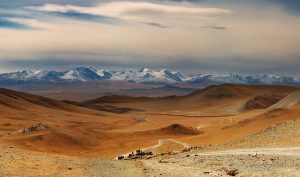In recent years, Mongolia has made major leaps in managing and improving its environmental policies. Mongolia’s heavy dependence on its natural resource extraction along with misuse has created long-lasting environmental damage, desertification, and land degradation. These issues require attention from policymakers and the international community. The long-term strategic goal for Mongolia is to implement a sustainable strategy that combats desertification while increasing economic opportunity with diverse environmental benefits.
Beyond the Mongolian people’s strong traditional ties to their environment, desertification comes at a major cost. As urbanization continues to sprawl in Ulaanbaatar, the capital of Mongolia, the countryside is left to be utilized for mining and pastoralism.
According to a 2020 report from the United Nations Development Program (UNDP), 76.9 percent of Mongolia’s land is affected by desertification. One of the leading causes of desertification is how the pastoral lands are managed, regulated, and administered within each province. For example, the culmination of decades of “overgrazing, unplanned mining, and road and transportation use” is the main cause of environmental damage in economic zones such as the Eastern Gobi and the Central Mongolian plateau.
However, combating desertification is not a new issue for Mongolian policymakers. Different administrations have taken steps to tackle desertification since the mid-1990s.
In 1994, Mongolia signed the U.N. Convention to Combat Desertification in Paris, France. Even back in 1997, Mongolia was aware of its vulnerabilities to desertification and had identified four main causes: deforestation, overgrazing, inappropriate use of lands, and poorly planned road networks. Thirty years later, Mongolia’s economy is 90 percent dependent on its mining sector and the environmental damage that these activities have caused urgently requires policy attention.
The international community has been supportive of Mongolia’s active engagement in improving its desertification issues. In 2020, the UNDP’s Green Climate Fund approved a $23.1 million grant for Mongolia’s vulnerable herder community, which is experiencing desertification and climate change issues firsthand.
In 2023, Mongolia and the International Trade Center co-hosted the World Export Development Forum, which attracted businesses, entrepreneurs, environmentalists, and people from the digital sector aiming to incorporate “organic, digital, and sustainable solutions” to Mongolia’s development. Such initiatives create opportunities for increasing investments and collaboration in environmentally friendly projects.
Moreover, since its launch in 2021, Mongolian President Khurelsukh Ukhnaa’s flagship “1 Billion Tree” initiative has been well-received by grassroots organizations as well as mining conglomerates. In May, state-owned Erdenes Mongol reported that in two years the company has planted 13.3 million trees. Oyu Tolgoi, responsible for the massive copper and gold mine of the same name, pledged to plant 100 million trees. Since 2021, more than 41 million trees have been planted and another 30 million are scheduled this year.
Mongolia’s efforts to tackle desertification are receiving support from the international community and partners. U.N. Secretary General Antonio Guterres made a point of planting a tree himself during his 2022 visit to Mongolia, the first by a U.N. leader since 2009.
The latest visit of Ibrahim Thiaw, the under-secretary-general and executive secretary of the United Nations Convention to Combat Desertification (UNCCD), showed immense support for Mongolia’s increasing role in environmental protection and management.
According to the UNCCD’S 2024 “Global Land Outlook Thematic Report on Rangelands and Pastoralists,” which was launched in the Mongolian capital, “In Central Asia and Mongolia, 60 percent of the land area is used as grazing rangelands, with livestock herding supporting nearly one-third of the region’s population.” These numbers illustrate the importance of healthy ecosystems for pastoral societies, which need strategic policy, planning, and management to overcome environmental vulnerabilities.
From an environmental perspective, despite the economic benefits, decades of overuse have led to biodiversity loss, soil erosion, and increasingly unstable climate and extreme weather. Earlier this year, a dzud killed millions of livestock, just the latest example of how climate change is altering Mongolia’s nomadic lifestyle. To combat these challenges Mongolia’s strategy needs to be solid and well-planned.
Mongolia’s approach to rangeland management includes several key strategies.
First, integrating climate change mitigation and adaptation strategies with sustainable rangeland management plans can increase carbon sequestration and boost community resilience. Because of the diverse ecosystems in each region, Mongolia will need diverse expertise in management.
The hope is that supporting pastoralism-based strategies will help mitigate the overlapping harms of climate change, overgrazing, soil erosion, invasive species, drought, and wildfires.
Mongolia’s strategic initiatives look to international experiences and local communities to conserve, not convert. By fostering sustainable rangeland management, supporting local pastoralist communities, and advocating for robust policies, Mongolia’s fight against desertification can be a case study for Central Asian countries.
These practices are aimed not only to increase awareness of environmental issues but also to protect and manage these vast lands for future generations at a policy level. Mongolia is committed to spending 1 percent of its GDP – which would be roughly $195 million in 2024 – annually on combating climate change and desertification.
Coinciding with the International Year of Rangelands and Pastoralists, Mongolia will host the 17th UNCCD Conference of the Parties in 2026.

































